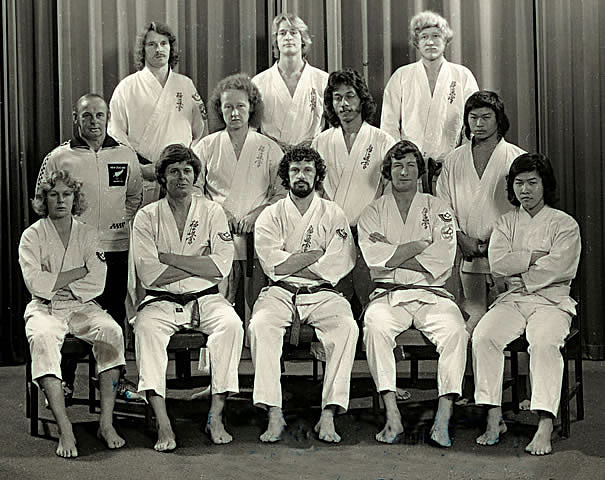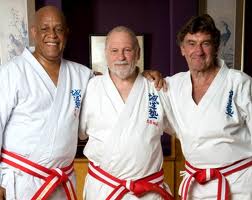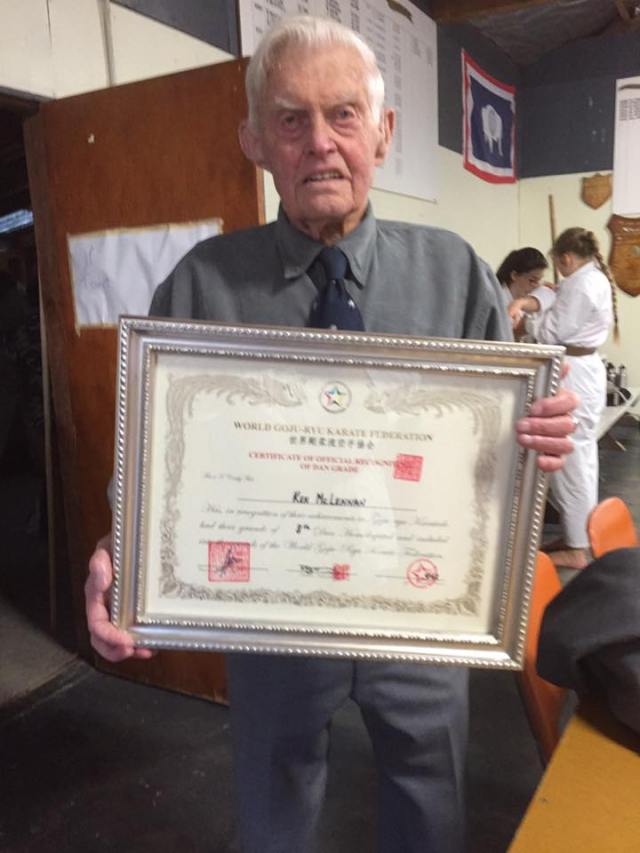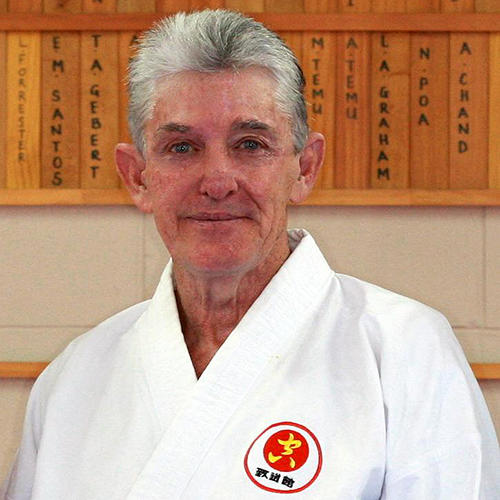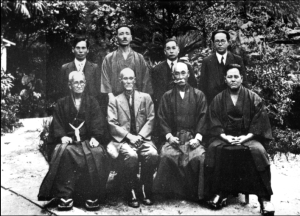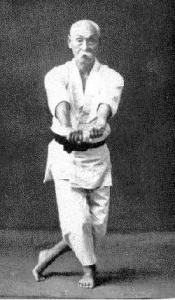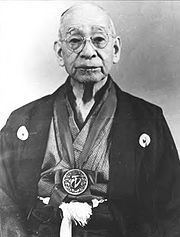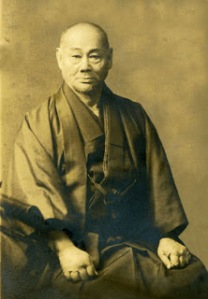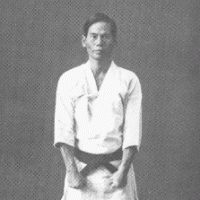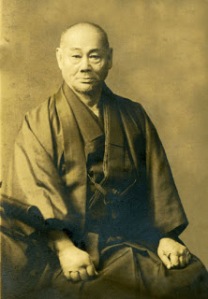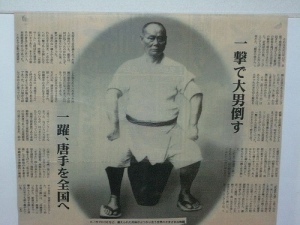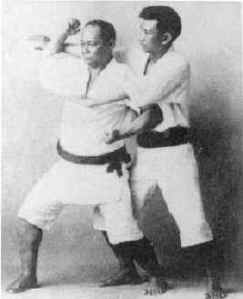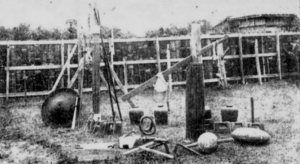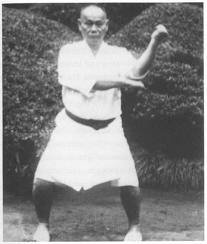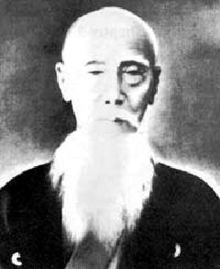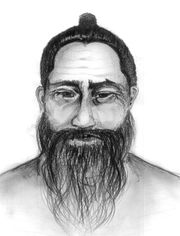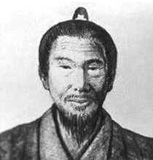This is one of an occasional series of portraits of karate leaders from Aotearoa New Zealand taken from martial arts magazines from the 1970’s and 1980’s.
Master Bob Johnson ~ White Tiger Kung Fu
Taken in New Zealand, 1964 by Stan Chun
Robert Henry Johnson was born 30th August 1931, in Leicester, England. Bob’s father, Ernest Johnson worked in the Military Police in Northern India in the 1930s until sometime during the 2nd World War. As a boy Bob grow up in India and his father introduced him to an Ustad (teacher) Nihung warrior, where he spent several years learning the Sikh fighting arts. Bob and his family returned to Leicester, England around 1945. In the following years, Bob is believed to have continued his martial arts studying Karate before at the age of 18 he joined the Royal Military Police. 1949, he was posted to Hong Kong, stationed at the Aberdeen Barracks. This was also the year that the Communist party took over China and outlawed martial arts and so consequently many Kung Fu masters who had enjoyed revered positions now escaped persecution by escaping China via Hong Kong.
Bob stated he was spurred into taking up Kung Fu after seeing a street fight in Hong Kong. Master Wong Cheung had been attacked, but easily and skilfully dealt with his attackers. Bob introduced himself to Master Wong and persuaded him to teach him this strange martial arts called Black Tiger Kung Fu. Master Wong taught Bob on a one to one basis at his gym by the railway sidings at Mon Kok station in Hong Kong. Due to Bob’s prowess as a fighter, he was invited into a special enclave of Kung Fu masters. This enclave of Masters, would meet and exchange ideas from their styles for practical fighting purposes. These styles included Black Tiger, White Tiger, Ripping Tiger, Bagua, Wing Chun and Hsing I. It appears that over these years Bob grow closer to one master in particular called T Wong and kept in touch with him over the next two decades. T Wong taught the styles of White Tiger, Bagua and Hsing I.
While in Hong Kong, Bob bumped into a friend who was from his home town back in England. Pete McNulty lived in the next street from Bob back in Leicester. Pete was a solo SAS observations operative who had to flee Korea as his cover had been blown. He was sent to Hong Kong as an adviser to the Civil Police. At this time it was unheard of for Whites / Europeans to be accepted into any Kung Fu schools and taught. The only way that Bob and Pete gained access was through their Police and Military Chinese contacts and the friendships they had built up with these people. On many occasions Bob would have his abilities tested in his role a Military Police Officer performing his duties. Another time he had to fight for his life along when he was caught in the middle of a fight between two rival gangs on the ferry crossing the harbour. It is also rumoured that he tested himself by entering No-holds barred full contact fights with other martial artists in Hong Kong.
It is known that Bob was first introduced to the knowledge of the Sikh fighting arts through spending time with his father in India. This was reignited when he was serving in Hong Kong working with the local police there. The ruling British relied heavily on the Sikh community because of their honour and unswayable loyalty to make up the majority of the police force during those colonial years. It is very possible that Bob’s love of the martial arts combined with his close connection to the Hong Kong Sikh police fraternity who would have worked closely with the military police at that time could have been Bob`s inroad to gaining information on the Sikh fighting arts.
In November 1951, Bob left Hong Kong and travelled to Bulsar in the Northern Indian state of Gujarat, and there located a Nihung called Cheda Singh, who was a much revered Ustad (Teacher) in the art of Yudh Vidya. After being accepted as a student, Bob then spent several years living and training with Ustad Cheda Singh and his Nihung warriors becoming a Sikh himself. On the completion of Bob’s training at Bulsar, he was ordered to be marked by the Nihungs who tattooed his forearms.
Bob then returned home to England for a brief period before then heading to New Zealand in 1956 to meet up with his Kung Fu teacher T Wong who was now at Dunedin University. After several months of intensive training, Bob was awarded his Kung Fu masters certificate by T Wong.
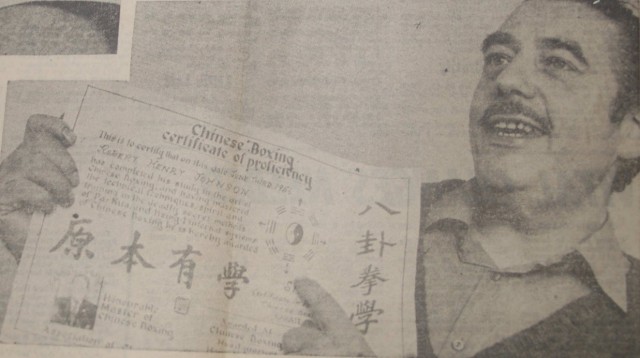
Bob showing his Master certificate in Kung Fu (photo taken in New Zealand, 1974 for newspapers)
Wong then returned to Hong Kong, so Bob travelled to Wellington on the north island of New Zealand and studied Kyokushinkai karate under Master P Mizutane, who had himself trained in Tokyo, Japan under Master Oyama the founder of Kyokushinkai Karate. Due to Bob’s previous training he soon advanced in Karate and was awarded his 1st Dan in 1957. After achieving this grade, he then returned back to England and started teaching under the name of Chinese Karate.
After several years building up an association with several assistant instructors Bob decided to emigrate New Zealand in 1963. While in New Zealand Bob lived in a suburb of Wellington called Brooklyn. He started to teach and build up a club which he ran from a large shed in his back garden. It is believed that he was also studying himself while there, expanding his skills and knowledge. When Bob returned to England in 1964, he advised his most senior student, Stan Chun to continue his studies of Kung Fu under another local Master, called Bill Young who he respected after a challenge match.
It was after his return from New Zealand that Bob finally moved away from the Karate and focused exclusively on teaching Kung Fu to all his students. In these early days, Kung Fu was not yet widely known to the general public who considered martial arts to be either Karate or Judo. Because to this, Bob decided he would use the name of Chinese Karate to let the general public know what he was about. When he came back from New Zealand in 1964 he designed a new badge for his Tai Gik Koon association. At the top, it had “Chinese Karate Association” and at the bottom “Hong Kong New Zealand”. The reference to Hong Kong and New Zealand, is to do with where Bob Johnson’s had studied Kung Fu.

From the early 1960’s, Bob started to expand, and taught at various locations around Leicestershire. One of these venues was outside in Bradgate Park, and classes were held regardless of weather conditions. As the sixties progressed, Bob started to build a hardcore of very good instructors (Pete Bradshaw, Pete McNulty, Roger Le Butt, Chris Hubbard and Tom Carey), who had opened up their own clubs in the surrounding areas. As these clubs continued to grow and expand to other locations, Bob set up his Tai Gik Koon association. At this time in the UK, martial arts were still in its infancy and all the main instructors knew each other and would visit and train at each other’s clubs. From the late1960’s Bob and Tom Carey formed an alliance and co-operated closely with each other in an attempt to stop disreputable instructors deceiving the public.
Although Bob had a thriving martial arts association he would still keep down a full time job as well as teaching Kung Fu and would also have periods working the doors at various clubs. Door work was always a way of pressure testing his techniques in real situations. Another way Bob used to pressure test his system was to issue challenges to other clubs and styles. Many took up these challenges through the years which Bob or one of his top instructors would always defeat all challengers upholding the honour of the club.
At this time Bob had thirty three clubs around the country in his Tai Gik Koon association. In early 1973, Bob was getting business advice off an associate who funded a three week trip to Hong Kong. Bob took this associate to Hong Kong with him, and introduced him to some of his friends and past teachers. On his return, he told Roger Le Butt that it had been a mutual exchange where Bob was taught some things and he taught some of the other arts he had learnt since. It was then that Kung Fu really started to take off with the release of Bruce Lee’s films and the Kung Fu TV series with David Carradine. With the Kung Fu craze now sweeping across Britain, Bob started to get a lot more exposure in the press and television. Bob and his senior instructors were involved in two television programs. One was the David Frost show called “In The Street Where You Live”, and the other was for the local Midlands station, ATV. These two shows generated a huge response in people wish to learn from Bob and his instructors. Bob’s Tai Gik Koon association expanded at a fantastic rate due to the public’s demand for Kung Fu.
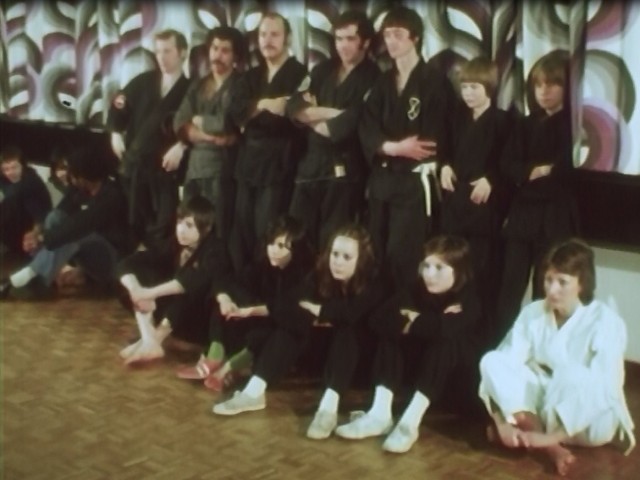
Back row: Roger Le-Butt, Pete Coburn, Bob Lodge, Chris Hubbard, Dave Rose, Jason Smith & Bradley Smith
At the height of Bob’s success in 1974, he strangely decided to emigrate to New Zealand, leaving his assistants to run the clubs in his absence. While In New Zealand Bob again taught his system and met up with old friends Bill Young and Stan Chun. Bill had now built up a large association in Wellington called the Chinese Martial Arts Association and asked Bob to come down from time to time and teach.
In February 1975, Bob returned back to England after his family had become homesick and had pleaded with him to return back home to Leicester. Bob took back over the reins of his clubs which surprised some of his instructors who hadn’t expected him to return. Bob wasn’t pleased at some of the changes that had been made and put them straight in his own way. Due to this, some of these people started to distance themselves from regular contact with Bob.
Approximately 1977, Bob decided to break ties with the British Kung Fu Council, stating that he wasn’t happy with their organisation, its egos and the fact it didn’t operate a proportional representation in its voting system (as Bob had by far the greatest number of members and resented being reduced to having the same say in any votes as an instructor who’s organisation had only a few members.), and Bob didn’t like being told what to do by people whom he considered inferior martial artists. Unfortunately Bob’s good friend Tom Carey developed arthritis and retired from teaching in 1977.
During the early 1980s, one of Bob’s old students called Gordon Hooke opened up a club in Leicester with Bob’s permission and began teaching White Tiger Kung Fu. The White Tiger system that Bob taught was a blend of all the various styles he had experienced to produce a fast and effective self-defence and fighting art. He wanted a system like he encountered in the fighters enclave in Hong Kong. Some people wanted a more traditional style and so missed called Bob for creating his unique hybrid system. Bob used to say `We are not Chinese, Japanese or Indian, we sit on chairs not on the floor and so we don’t use the long low stances for self-defence and fighting. Real fighting is about doing what is natural, and enhancing your normal body movements`.
During the 1960s, 70s and 80s Bob also taught at the Guru Nanak Gurdwara on New Walk in Leicester. It was only in the mid -980s that he allowed some on his instructors into the Gurdwara with him to help him teach his Sikh students.

After many years of unscrupulous people copying Bob claiming to teach Kung Fu, he decided in 1983 to change his styles name from Kung Fu to Muka Bazi. He knew that this was a more obscure name that people would not imitate. His style had always been a practical blend of Chinese Kung Fu and the Sikh Indian fighting arts known today as either Gatka or Shaster Vidya. As a sign of respect to his Nihung teachers and the Sikh community, he used the more common generic term of Muka Bazi as a smoke screen to hide his real Nihung teachings. During the next several years, Bob expanded his syllabus to include a lot more of the Indian techniques that he had previously held back.
Towards the late 1980’s Bob started to take a back seat after he developed diabetes and then gout. He still oversaw the association turning up at his students various lessons from time to time. Bob’s main instructor, who was running his class was Pete Thorn. Pete would turn up at classes with a lever arch file, which contained the various tiger forms, and a Muki Bazi Binot form (the forms are of twenty complex techniques) plus information on Pakua and Dim Mak techniques. All this information had been written down in the early 1970’s so that his system stayed true and wouldn’t be corrupted.
Bob’s unexpected death came on the 1st August in 1994.
Pete Thorn continued to teach until he again retired in 1995, but happily returned to teaching Bobs original style again in 2008 at Gordon Hooke’s club in Leicester.
For a more detailed history of Bob Johnson, then please read “Way of the White Tiger”, written by Paul Burkinshaw. This book is available from Paul at his academy in Bedworth or contact him by
email: paulburkinshaw@yahoo.co.uk
or
Tel: 07973 421860






